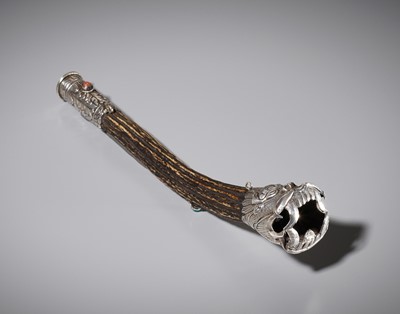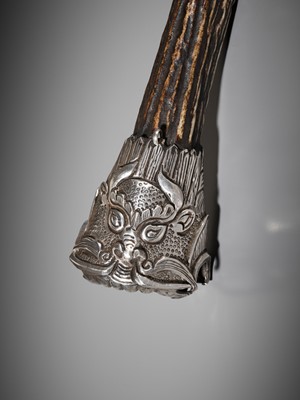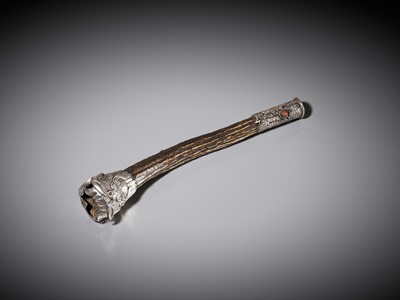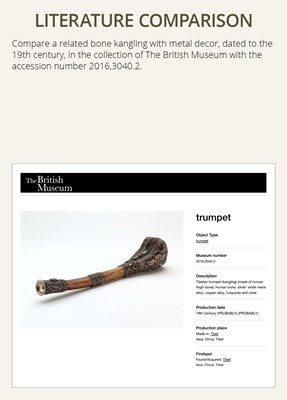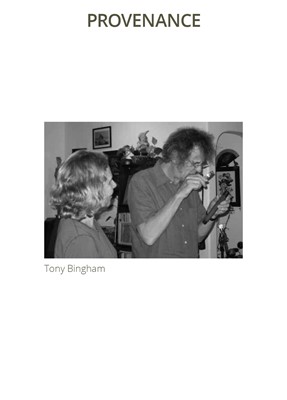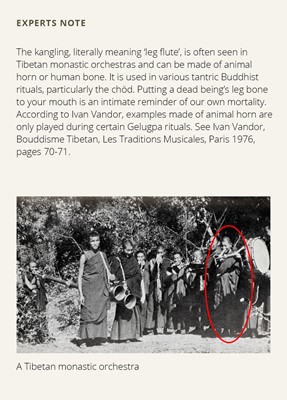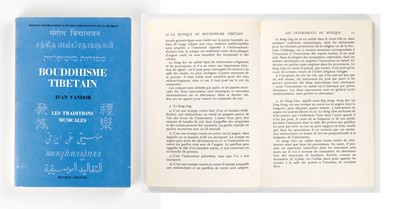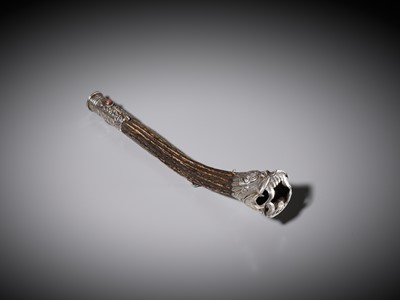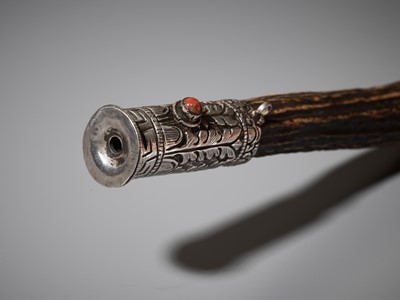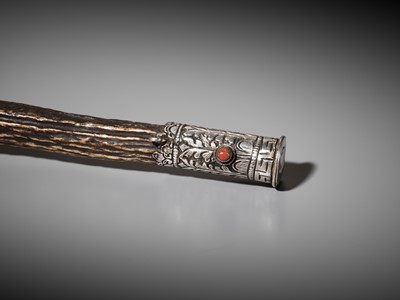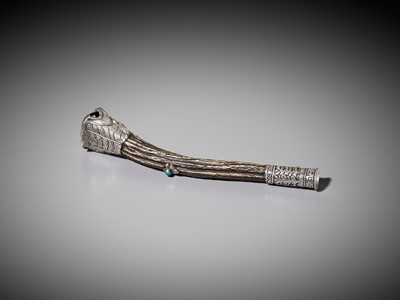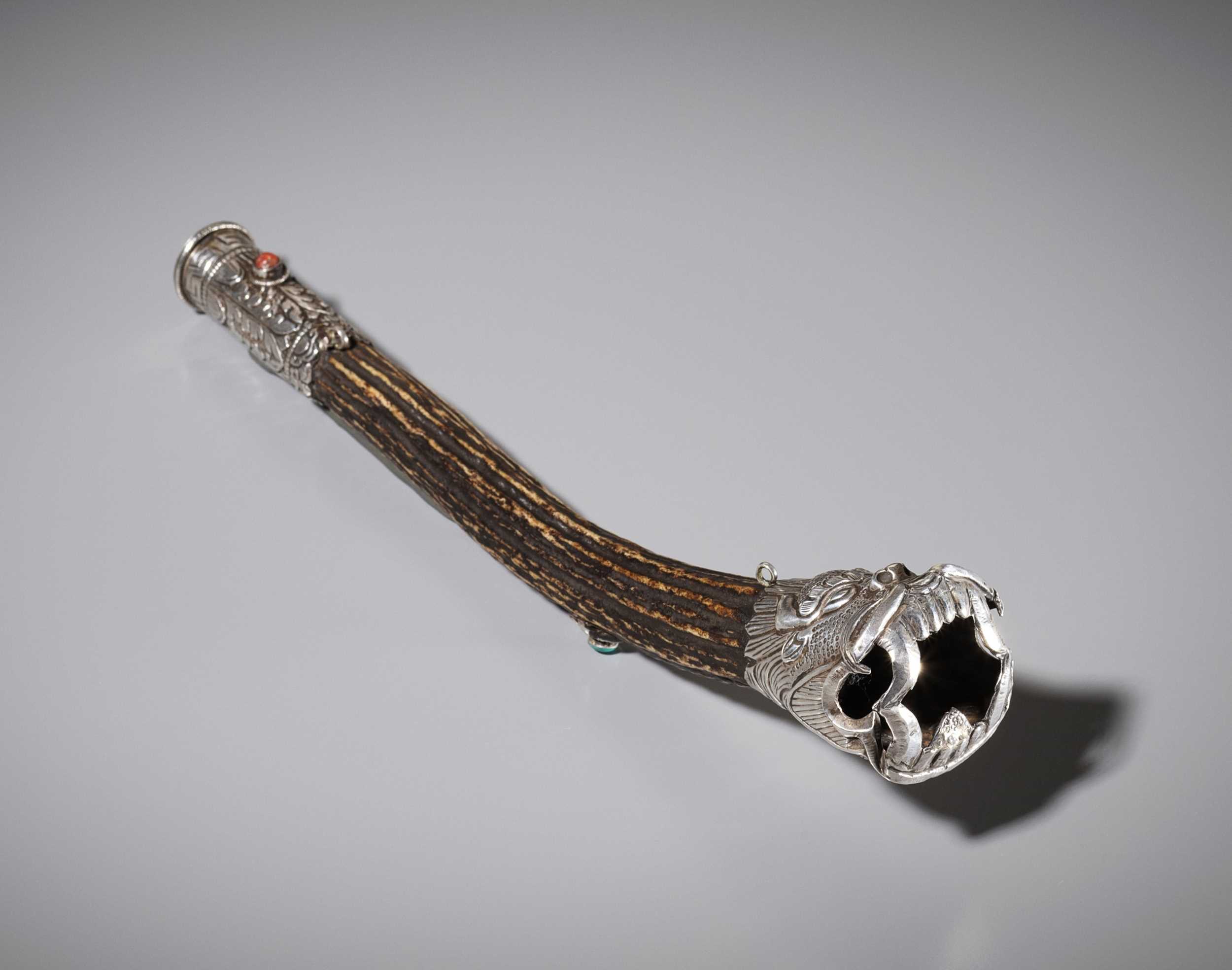30th Sep, 2022 10:00
DAY 2 - TWO-DAY AUCTION - Fine Chinese Art / 中國藝術集珍 / Buddhism & Hinduism
549
A SILVER AND STAG ANTLER ‘MAKARA’ FLUTE, KANGLING, TIBET, 19TH CENTURY
十九世紀西藏銀質骨號(剛令)
Sold for €975
including Buyer's Premium
The stag antler trumpet with a silver repoussé mouthpiece and bell, the mouth piece decorated with key-fret, acanthus leaf, and petal designs and inset with a coral cabochon. The bell in the form of a fierce makara head with the mouth wide open revealing teeth and tongue, the stag antler further with a small floral fitting inset with a turquoise cabochon.
Provenance: From the collection of Tony Bingham, United Kingdom. Tony Bingham is a retired dealer of antique musical instruments. He and his wife Irene opened several stores in London beginning in the 1960s, where they were selling antique instruments to museums, private collectors, and musicians, for more than 40 years. He also published several books on the history of musical instruments, including The New Langwill Index, a Dictionary of Musical Wind-Instrument Makers and Inventors.
Condition: Excellent condition with minor old wear, few minuscule nicks and dents, occasional light scratches. Solid, naturally grown patina overall.
Weight: 173.0 g
Dimensions: Length 27.8 cm
Expert’s note: The kangling, literally meaning ‘leg flute’, is often seen in Tibetan monastic orchestras and can be made of animal horn or human bone. It is used in various tantric Buddhist rituals, particularly the chöd. Putting a dead being’s leg bone to your mouth is an intimate reminder of our own mortality. According to Ivan Vandor, examples made of animal horn are only played during certain Gelugpa rituals. See Ivan Vandor, Bouddisme Tibetan, Les Traditions Musicales, Paris 1976, pages 70-71.
The Chöd is a spiritual practice found primarily in the Yundrung Bön tradition as well as in the Nyingma and Kagyu schools of Tibetan Buddhism. Also known as ‘cutting through the ego’, the practices are based on the Prajnaparamita or ‘Perfection of Wisdom’ sutras, which expound the emptiness concept of Buddhist philosophy. According to Mahayana Buddhists, emptiness is the ultimate wisdom of understanding that all things lack inherent existence. Chöd combines Prajnaparamita philosophy with specific meditation methods and tantric ritual. The chöd practitioner seeks to tap the power of fear through activities such as rituals set in graveyards, and visualization of offering their bodies in a tantric feast in order to put their understanding of emptiness to the ultimate test.
Literature comparison:
Compare a related kangling, illustrated in Haags Gemeentemuseum, Musial instruments from the East- and South-East Asian mainland, The Hague, 1989, p. 225, no. 195. Compare a related bone kangling with metal decor, dated to the 19th century, in the collection of The British Museum with the accession number 2016,3040.2.
十九世紀西藏銀質骨號(剛令)
鹿角小號兩端銀錘鍱,管體上細下粗,略呈彎曲狀,下端喇叭口呈橢圓形。暴飲處鑲嵌圓形珊瑚。鈴鐺形狀為凶猛的摩迦儸頭,嘴巴張開,露出牙齒和舌頭,鹿角帶有小花卉紋,嵌有綠松石與圓形寶石。
來源:英國Tony Bingham收藏。Tony Bingham是一位退休的古董樂器經銷商。 他和他的妻子Irene上世紀六十年代初在倫敦開設了幾家商店。四十多年來,他們一直在向博物館、私人收藏家和音樂家出售古董樂器。 他還出版了幾本關於樂器歷史的書籍,包括《新朗威爾索引》,一部音樂管樂器製造商和發明家詞典。
品相:狀況良好,有輕微磨損、些微刻痕和凹痕,以及局部劃痕。整體包漿。
重量:173.0克
尺寸:長27.8厘米
專家注釋:剛令,字面意思是“腿笛”,經常出現在西藏寺院管弦樂隊中,可以用動物角或人骨製成。它用於各種密宗佛教儀式,特別是施身法。將死者的腿骨放在嘴邊是對我們自己的死亡的提醒。據Ivan Vandor說,動物角製成的例子只在某些格魯派儀式中出現過。見Ivan Vandor,《Bouddisme Tibetan, Les Traditions Musicales》,巴黎,1976年,頁70-71。
文獻比較:
比較一件相近的剛令,見海牙美術館,《Musial instruments from the East- and South-East Asian mainland》,海牙,1989年,頁225,編號195。比較一件相近的十九世紀鑲嵌金屬骨剛令,收藏於大英博物館,2016,3040.2。
The stag antler trumpet with a silver repoussé mouthpiece and bell, the mouth piece decorated with key-fret, acanthus leaf, and petal designs and inset with a coral cabochon. The bell in the form of a fierce makara head with the mouth wide open revealing teeth and tongue, the stag antler further with a small floral fitting inset with a turquoise cabochon.
Provenance: From the collection of Tony Bingham, United Kingdom. Tony Bingham is a retired dealer of antique musical instruments. He and his wife Irene opened several stores in London beginning in the 1960s, where they were selling antique instruments to museums, private collectors, and musicians, for more than 40 years. He also published several books on the history of musical instruments, including The New Langwill Index, a Dictionary of Musical Wind-Instrument Makers and Inventors.
Condition: Excellent condition with minor old wear, few minuscule nicks and dents, occasional light scratches. Solid, naturally grown patina overall.
Weight: 173.0 g
Dimensions: Length 27.8 cm
Expert’s note: The kangling, literally meaning ‘leg flute’, is often seen in Tibetan monastic orchestras and can be made of animal horn or human bone. It is used in various tantric Buddhist rituals, particularly the chöd. Putting a dead being’s leg bone to your mouth is an intimate reminder of our own mortality. According to Ivan Vandor, examples made of animal horn are only played during certain Gelugpa rituals. See Ivan Vandor, Bouddisme Tibetan, Les Traditions Musicales, Paris 1976, pages 70-71.
The Chöd is a spiritual practice found primarily in the Yundrung Bön tradition as well as in the Nyingma and Kagyu schools of Tibetan Buddhism. Also known as ‘cutting through the ego’, the practices are based on the Prajnaparamita or ‘Perfection of Wisdom’ sutras, which expound the emptiness concept of Buddhist philosophy. According to Mahayana Buddhists, emptiness is the ultimate wisdom of understanding that all things lack inherent existence. Chöd combines Prajnaparamita philosophy with specific meditation methods and tantric ritual. The chöd practitioner seeks to tap the power of fear through activities such as rituals set in graveyards, and visualization of offering their bodies in a tantric feast in order to put their understanding of emptiness to the ultimate test.
Literature comparison:
Compare a related kangling, illustrated in Haags Gemeentemuseum, Musial instruments from the East- and South-East Asian mainland, The Hague, 1989, p. 225, no. 195. Compare a related bone kangling with metal decor, dated to the 19th century, in the collection of The British Museum with the accession number 2016,3040.2.
十九世紀西藏銀質骨號(剛令)
鹿角小號兩端銀錘鍱,管體上細下粗,略呈彎曲狀,下端喇叭口呈橢圓形。暴飲處鑲嵌圓形珊瑚。鈴鐺形狀為凶猛的摩迦儸頭,嘴巴張開,露出牙齒和舌頭,鹿角帶有小花卉紋,嵌有綠松石與圓形寶石。
來源:英國Tony Bingham收藏。Tony Bingham是一位退休的古董樂器經銷商。 他和他的妻子Irene上世紀六十年代初在倫敦開設了幾家商店。四十多年來,他們一直在向博物館、私人收藏家和音樂家出售古董樂器。 他還出版了幾本關於樂器歷史的書籍,包括《新朗威爾索引》,一部音樂管樂器製造商和發明家詞典。
品相:狀況良好,有輕微磨損、些微刻痕和凹痕,以及局部劃痕。整體包漿。
重量:173.0克
尺寸:長27.8厘米
專家注釋:剛令,字面意思是“腿笛”,經常出現在西藏寺院管弦樂隊中,可以用動物角或人骨製成。它用於各種密宗佛教儀式,特別是施身法。將死者的腿骨放在嘴邊是對我們自己的死亡的提醒。據Ivan Vandor說,動物角製成的例子只在某些格魯派儀式中出現過。見Ivan Vandor,《Bouddisme Tibetan, Les Traditions Musicales》,巴黎,1976年,頁70-71。
文獻比較:
比較一件相近的剛令,見海牙美術館,《Musial instruments from the East- and South-East Asian mainland》,海牙,1989年,頁225,編號195。比較一件相近的十九世紀鑲嵌金屬骨剛令,收藏於大英博物館,2016,3040.2。
Zacke Live Online Bidding
Our online bidding platform makes it easier than ever to bid in our auctions! When you bid through our website, you can take advantage of our premium buyer's terms without incurring any additional online bidding surcharges.
To bid live online, you'll need to create an online account. Once your account is created and your identity is verified, you can register to bid in an auction up to 12 hours before the auction begins.
Intended Spend and Bid Limits
When you register to bid in an online auction, you will need to share your intended maximum spending budget for the auction. We will then review your intended spend and set a bid limit for you. Once you have pre-registered for a live online auction, you can see your intended spend and bid limit by going to 'Account Settings' and clicking on 'Live Bidding Registrations'.
Your bid limit will be the maximum amount you can bid during the auction. Your bid limit is for the hammer price and is not affected by the buyer’s premium and VAT. For example, if you have a bid limit of €1,000 and place two winning bids for €300 and €200, then you will only be able to bid €500 for the rest of the auction. If you try to place a bid that is higher than €500, you will not be able to do so.
Online Absentee and Telephone Bids
You can now leave absentee and telephone bids on our website!
Absentee Bidding
Once you've created an account and your identity is verified, you can leave your absentee bid directly on the lot page. We will contact you when your bids have been confirmed.
Telephone Bidding
Once you've created an account and your identity is verified, you can leave telephone bids online. We will contact you when your bids have been confirmed.
Classic Absentee and Telephone Bidding Form
You can still submit absentee and telephone bids by email or fax if you prefer. Simply fill out the Absentee Bidding/Telephone bidding form and return it to us by email at office@zacke.at or by fax at +43 (1) 532 04 52 20. You can download the PDF from our Upcoming Auctions page.
How-To Guides
How to Create Your Personal Zacke Account
How to Register to Bid on Zacke Live
How to Leave Absentee Bids Online
How to Leave Telephone Bids Online
中文版本的操作指南
创建新账号
注册Zacke Live在线直播竞拍(免平台费)
缺席投标和电话投标
Third-Party Bidding
We partner with best-in-class third-party partners to make it easy for you to bid online in the channel of your choice. Please note that if you bid with one of our third-party online partners, then there will be a live bidding surcharge on top of your final purchase price. You can find all of our fees here. Here's a full list of our third-party partners:
- 51 Bid Live
- EpaiLive
- ArtFoxLive
- Invaluable
- LiveAuctioneers
- the-saleroom
- lot-tissimo
- Drouot
Please note that we place different auctions on different platforms. For example, in general, we only place Chinese art auctions on 51 Bid Live.
Bidding in Person
You must register to bid in person and will be assigned a paddle at the auction. Please contact us at office@zacke.at or +43 (1) 532 04 52 for the latest local health and safety guidelines.
